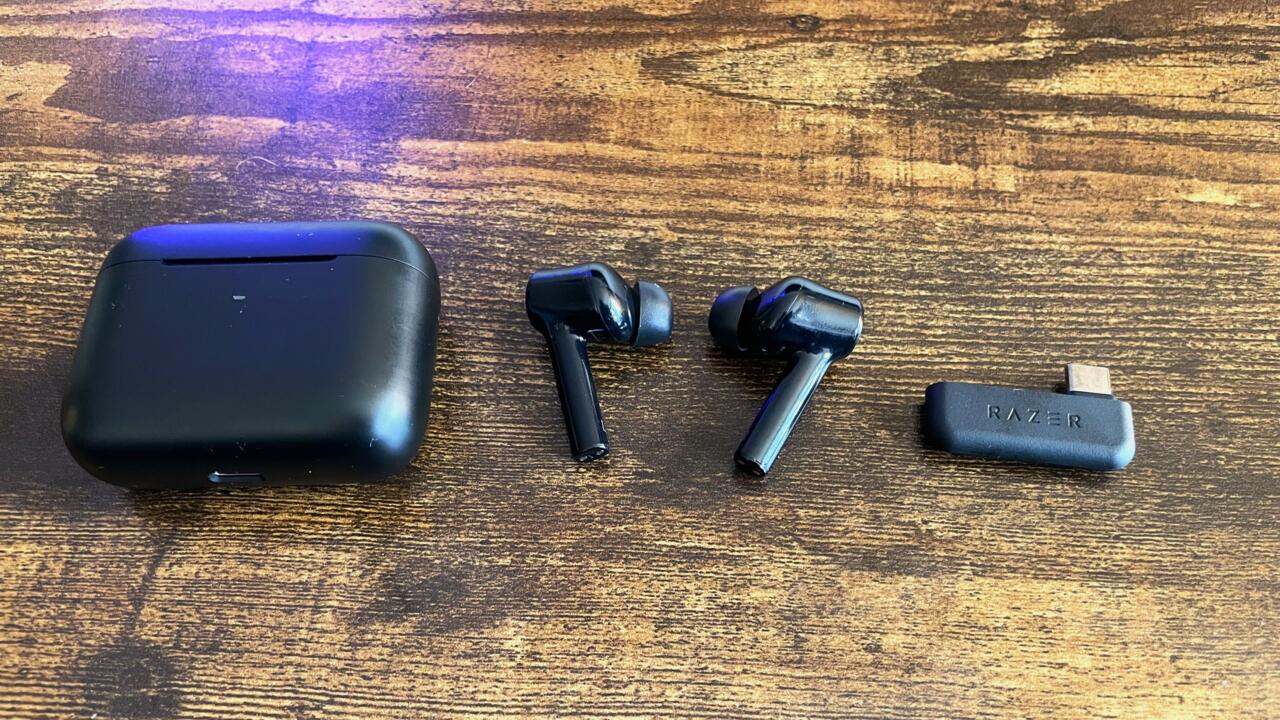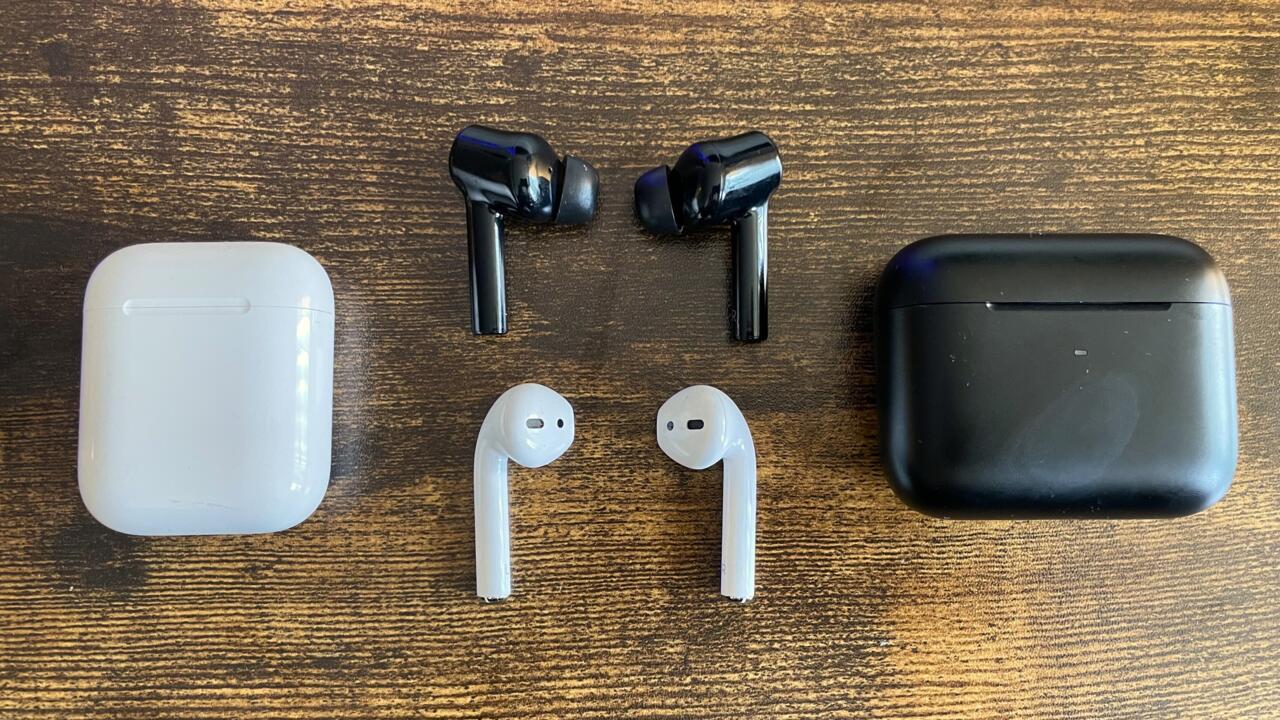I’ve always thought of wireless earbuds as the audio option you use for convenience’s sake. When I’m out and about listening to music or podcasts, a decent set of earbuds will do the trick and be a lot less cumbersome than moving in public in a pair of headphones. And sometimes wired earbuds plugged into my PlayStation or Xbox controller are just good enough. There are certainly high-end earbuds out there, but wireless options are often beholden to Bluetooth connectivity and in the context of gaming, the latency is certainly a deal-breaker. But one of the few pairs of earbuds that bridges the gap–the Razer Hammerheads (the Pro Hyperspeed model, specifically)–offers both great audio quality and low-latency connectivity.
But if the question is can earbuds–the Razer Hammerheads in this case–replace a gaming headset, the short answer would be: yes, but with some notable caveats. While they shine with bold sound and solid bass, the battery life is the main drawback, especially when it comes to long gaming sessions. The Hammerheads have useful features to boot, like active noise canceling (ANC), ambient listening mode, and a low-latency wireless mode in addition to the 2.4GHz dongle that offers even lower latency. This gives them a level of versatility rarely seen in other gaming-centric audio devices, just expect to be popping these into the charging case often. And expect to drop a whopping $200 USD for them.

Sound Quality
I’ve used the Razer Hammerhead earbuds for about a week, replacing my standard Apple AirPods for listening to music and podcasts from my phone and the various headsets I have for my multiple gaming setups. This includes a Nintendo Switch, PlayStation 5, Asus ROG Ally handheld, and gaming PC, all of which let me experience how the Hammerheads perform in varied contexts.
Across the board on the default sound profile (denoted as “THX” in the Razer Audio app), the punchy lows shined without overpowering other frequencies, whether it was the diverse instrumentation heard in the J-Pop and Latin music currently in my playlist, or the bass-heavy hip-hop that’s frequently in my regular rotation. With ANC on, I could hear conversations in podcasts well enough while riding the old noisy BART trains here in the Bay Area. The Hammerheads’ ANC doesn’t offer complete sound isolation (and I generally prefer not to use ANC to be aware of my surroundings), but it’s a decent perk for certain situations.
When it came to gaming, I was impressed with how they handled the bold orchestrations in Final Fantasy XVI playing over chaotic battles full of abilities firing off and sound effects clashing with each other. It can be audibly overwhelming and lower quality setups make all these elements sound like they mush together, but the Hammerheads gave a pleasant listening experience. On the PS5, I had to use the super-fast 2.4GHz wireless dongle, but on the Switch and Asus ROG Ally, I switched to the low-latency Bluetooth “gaming” mode. For Zelda: Tears of the Kingdom and Diablo 4, respectively, I was pretty thrilled to be getting headset-level quality from earbuds without having to fret about gameplay and audio being out of sync.
By nature of being earbuds, the Hammerheads don’t provide as wide of a soundstage of the open-back Sennheiser HD 599 headphones I use on the regular–not that I expected them to. But the positional audio is quite impressive, which I got to experience when playing a few rounds of Valorant and running dungeons in Final Fantasy XIV. While I could have used the Bluetooth gaming mode with my PC for these games, I went back to the 2.4GHz wireless dongle to minimize latency as much as possible, and the responsiveness was similar to other wireless gaming headsets I’ve used, so I didn’t feel at a disadvantage when playing Valorant (skill issues aside).
Features and Functionality
It’s good hearing how Razer hasn’t skimped on sound quality when it comes to their high-end audio gear–and for $200, I wouldn’t expect anything less. On top of that, a handful of features give the Hammerheads great versatility. As mentioned above, you get the 2.4GHz USB-C dongle packaged with the Hammerhead Pro Hyperspeed for headset-grade wireless response time. My gripe with this, however, is the shape of the dongle itself–the “L” shape makes it difficult to plug into the back of my PC and blocks other ports around it. It’s a minor complaint that can be worked around, but if you plan to use these on a PC, I hope your USB-C ports don’t have important inputs around them.

Standard Bluetooth connectivity for music and podcasts worked well on my iPhone 12 Pro, although it was a pain getting my phone to remember the Hammerheads whenever I’d take them out of the case or take them out of my ears. Most times, auto-pairing worked as you’d expect, but occasionally having to manually pair them at seemingly random times was less than ideal. There are some weird quirks when it comes to automatic play/pause when taking out and putting on an earbud. A frequent example would be when I’m listening to a YouTube video; taking off an earbud would pause the video but autoplay music on Spotify. These aren’t deal-breakers, but rather inconveniences to account for.
And as mentioned above, the Bluetooth gaming mode is a crucial feature that allows for keeping audio and gameplay synced while having the perks of Bluetooth connectivity. It’s rated at around 60ms response time, and can be activated with a triple-tap-and-hold gesture on an earbud itself. And that’s good enough for the types of games I’m playing on a handheld anyway. ANC is decent enough to drown out outside annoyances or mitigate harsher noises, though it’s not quite as potent as other high-end earbuds. On the other hand, ambient mode slightly amplifies outside sounds for those who still want to be aware of their surroundings, which I always use when going outdoors.
Through the Razer Audio app (only available via iOS and Android), you can also remap the various gestures, such as ANC or ambient on/off, media controls, switching between Bluetooth and 2.4GHz, and activating Bluetooth gaming mode–this makes swapping between features easy, in addition to the manual controls on the app. Although I found the default “THX” profile sufficient, there are multiple sound profiles to choose from, and 10 frequency bands to tinker with yourself.
All these features are pretty sweet, but something has to give (aside from the “-$200” on your bank statement), which leads us to battery life.
Battery Life
When it comes to wireless earbuds, battery life is arguably as important as sound quality, comfort, or any of the other supporting features. After all, if they don’t last that long off a full charge, what good are they for all these various scenarios? Even compared to other earbuds I’ve used such as the Creative Outliers or my basic Apple Airpods (Gen 2), the Hammerheads fall behind on battery life, though how long they last depends on the features you’re using.

With ANC active and at about 75% volume level, I would get roughly 3.5 hours from a full charge, and slightly less when using the 2.4GHz connection or Bluetooth gaming mode. Without ANC and on standard Bluetooth, you can squeeze about 4.5 hours. For commutes, flights, long walks, or working through the day, I can manage with these ranges, as long as I remember to put them in their case before use. The case itself charges via USB-C, and it can hold over three full charges. Once the low battery indicator went off, I would pop the Hammerheads in the case and come back about 20 minutes later with both earbuds fully charged.
Comparatively however, other earbuds can get upwards of six hours or more in these scenarios. And of course, gaming headsets are in a completely different realm for battery life–for example, the Logitech G Pro X 2 that I reviewed a while back lasted an entire week from one full charge. In the case of gaming, where you may get deep in competitive matches, raids, or single-player campaigns, the short battery life can often cut into the momentum. I’d often just switch back to a headset and keep using it rather than waiting for the earbuds to charge up again. Part of this song and dance is just the nature of wireless earbuds, but even in its own class of audio devices, the Razer Hammerheads would be on the lower end.
Verdict
For all that the Razer Hammerhead Pro Hyperspeed earbuds accomplish, $200 is likely to be quite steep for most folks–you’re approaching high-end headsets and headphones at this price point. But when companies like Apple have their premium earbuds in that price range, Razer does give them a run for their money. Between the top-notch audio quality and set of features that make them more versatile than most earbuds, the Hammerheads are fantastic in that context. The value depends on how you plan to use them–if you want something as both a primary audio device for gaming and your everyday earbuds for music and podcasts, you’ll definitely be getting your money’s worth. The main hurdle is managing the relatively short battery life, and if that’s fine with you, I’m comfortable recommending the Razer Hammerheads.
The products discussed here were independently chosen by our editors.
GameSpot may get a share of the revenue if you buy anything featured on our site.
Stay connected with us on social media platform for instant update click here to join our Twitter, & Facebook
We are now on Telegram. Click here to join our channel (@TechiUpdate) and stay updated with the latest Technology headlines.
For all the latest Gaming News Click Here
